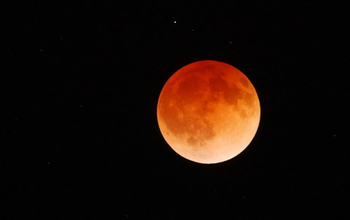![]()
Press Release 14-054
Red moon at night; stargazer’s delight![]()
NOAO offers front-row seat to lunar eclipse
|
Lunar eclipse, April 15, 2014. |
April 15, 2014
Monday night’s lunar eclipse proved just as delightful as expected to those able to view it. On the East Coast, cloudy skies may have gotten in the way, but at the National Science Foundation’s National Optical Astronomy Observatory (NOAO) near Tucson, Ariz., the skies offered impressive viewing, as seen from the pictures provided here.
Nicknamed a “blood moon,” this lunar eclipse’s color was similar to the majority of lunar eclipses. This has to do with the Earth’s atmosphere’s propensity for longer-wavelength light (e.g., the reds, oranges and yellows seen in sunrises and sunsets). However, according to NOAO Astronomer Stephen Pompea, the lunar eclipse’s hue means more than just a pretty moon.
“The study of the color of lunar eclipses can be used to understand dust in the stratosphere including the amount and particle size of dust injected by volcanic eruptions,” he said. “Understanding the amount of dust can help scientists create better models of climate change.”
For those who missed this lunar eclipse, fear not. Three more are to occur fairly soon: Oct. 8, 2014; April 4, 2015 and Sept. 27, 2015.
-NSF-
![]()
Media Contacts
Ivy F. Kupec, NSF, (703) 292-8796, ikupec@nsf.gov
Robert Sparks, National Optical Astronomy Observatory, 520-318-8313, rsparks@noao.edu
Stephen Pompea, National Optical Astronomy Observatory, 520-318-8285, spompea@noao.edu
![]()
The National Science Foundation (NSF) is an independent federal agency that supports fundamental research and education across all fields of science and engineering. In fiscal year (FY) 2014, its budget is $7.2 billion. NSF funds reach all 50 states through grants to nearly 2,000 colleges, universities and other institutions. Each year, NSF receives about 50,000 competitive requests for funding, and makes about 11,500 new funding awards. NSF also awards about $593 million in professional and service contracts yearly.
Useful NSF Web Sites:
NSF Home Page: http://www.nsf.gov
NSF News: http://www.nsf.gov/news/
For the News Media: http://www.nsf.gov/news/newsroom.jsp
Science and Engineering Statistics: http://www.nsf.gov/statistics/
Awards Searches: http://www.nsf.gov/awardsearch/
![]()
